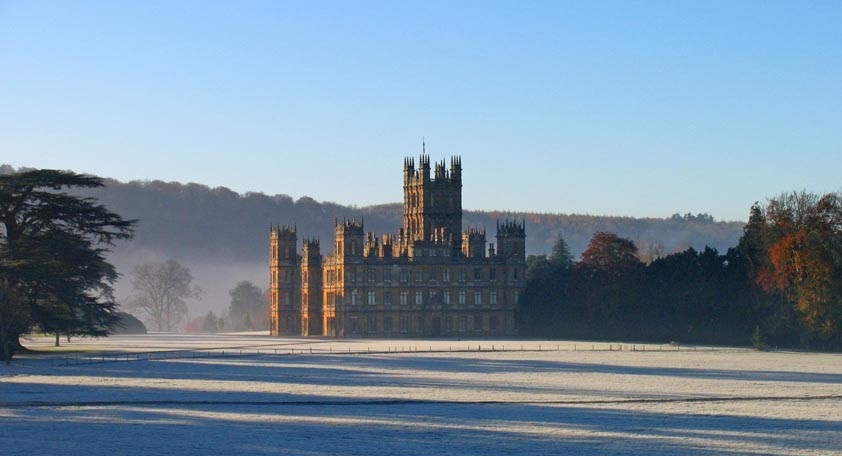
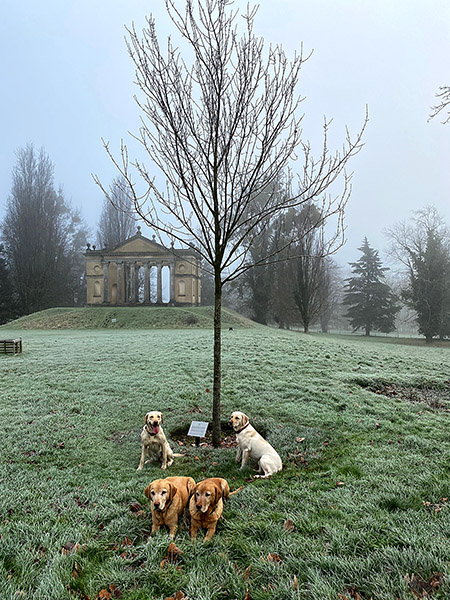 Walking across the apparently flat lawns toward Jackdaws Castle looking carefully at the ground as you go, you will see depressions and variances which mark the sites of what was there before: lost walls, fallen trees and old flower beds.
Walking across the apparently flat lawns toward Jackdaws Castle looking carefully at the ground as you go, you will see depressions and variances which mark the sites of what was there before: lost walls, fallen trees and old flower beds.
In Victorian times, this was a mass of much admired flower beds. They were lost over the course of two world wars, either deliberately removed or just hidden by overgrown brambles and fern. Without the pre-war staffing levels, grass was simply easier to maintain. Once you know they were there, they are relatively easy to spot. Given that they used to host azaleas in specially brought in ericaceous soil. From time to time we dig them out and replenish the naturally alkaline soil of what is basically a chalky hill top.
Now, in front and to one side of Jackdaws there is a new tree in an old bed – a maple tree. It is part of a diverse family, a genus that grows quickly throughout the northern hemisphere and they are renowned for their autumn colours. They are drought tolerant and can usually be recognised by their distinctive leaves. They have quite shallow roots and some of them, for example the paperbark maple, have beautiful cinnamon coloured bark that peels away.

The colours are seasonably variable, dark green in summer turning to a brilliant scarlet in autumn but are more predictable in neutral to acid soils and it prefers not to be planted in chalk. Therefore, we used one of the slight depressions from these earlier gardening endeavours in which to plant it and dug deeper to add in some new, additional, ericaceous soil as well. The new tree now stands sentinel and, over time, will add a beautiful highlight to the garden here even if it more usually found in Newfoundland, Nova Scotia, New Brunswick, Quebec or Ontario.
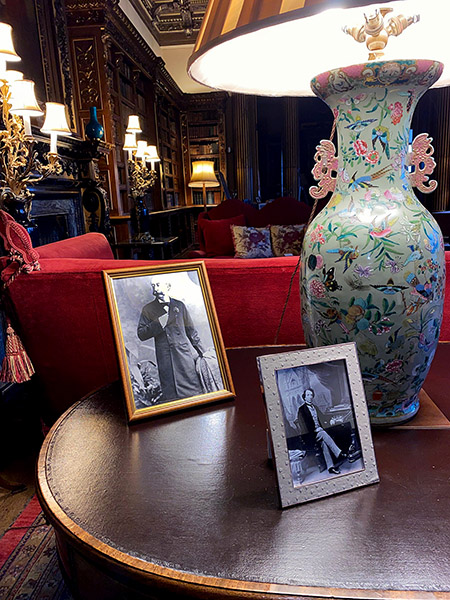
The 4th Earl and Sir John A
Most famously of course, the Maple Leaf is the emblem of Canada, the symbol on its national flag and the national tree of Canada. Hence the real reason it is planted in sight of the Library at Highclere: it was a gift from the people of Canada to Highclere in celebration of the 4th Earl of Carnarvon and his contribution to the birth of Canada during his life time in politics and specifically in Disraeli’s Cabinet in 1866.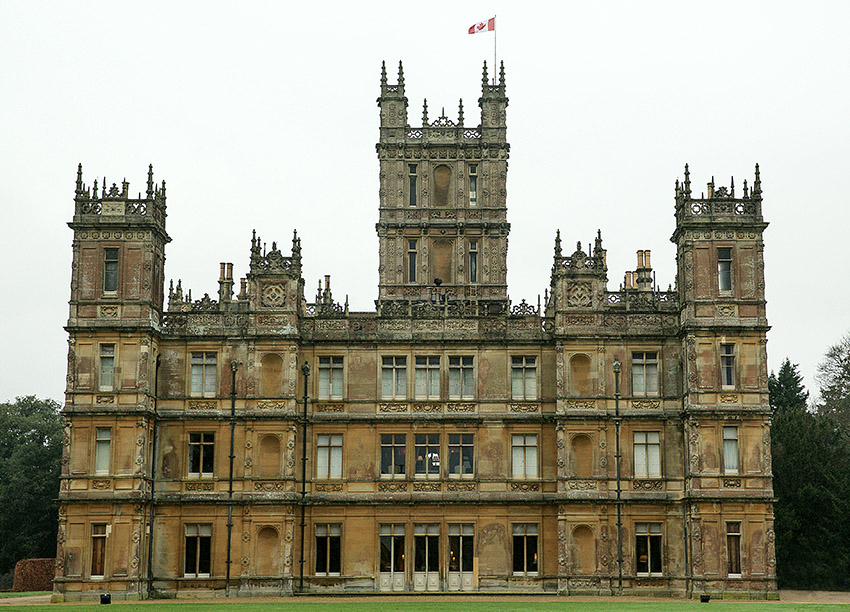
Today, January 11th, is the birthday of Sir John A Macdonald, founding father and first Prime Minister of Canada. Reading through the diaries, notes and letters between the 4th Earl and the founding fathers, it is clear that the constitution was drafted through compromise and consensus. It was, in modern terms, a team effort, with a set of principles established and a desire for checks and balances.
Lord Carnarvon had a number of strong tenets: for example the protection of minorities whether of religion, culture or language; he also felt that those who served in the senate should accept the position for a term, rather than for life, though not all agreed. The bill which Lord Carnarvon presented to Parliament was a compromise with enough “elastic” in the construction of a new constitutional infrastructure to make its way into the future. With retrospect, other agendas might have been included but all of these men, for better and worse, lived in the sensibilities of their time.
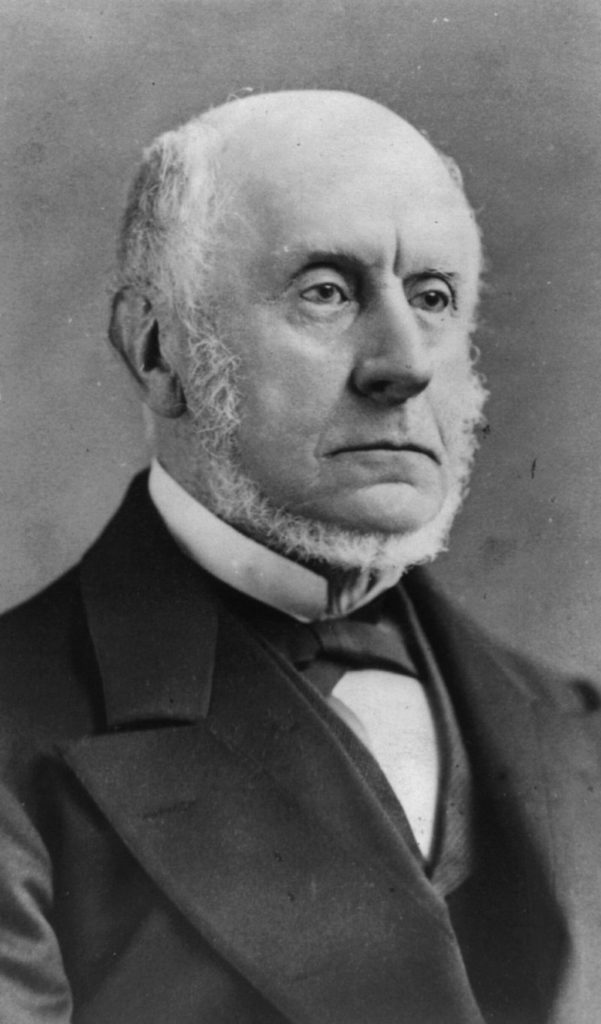
Charles Adams
Lord Carnarvon began his speech to present the Canada Bill in 1867 with descriptions of an extraordinary landscape, of the great trees, forests, lakes, rivers and oceans. It was a speech partly of romance but was set against a pressing political need to create Canada with all due speed. The US civil war had ended and neither the British, nor the inhabitants of this new country, wanted Canada subsumed into the USA.
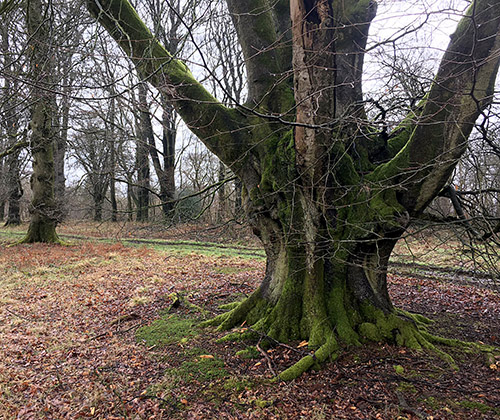
Highclere Beech trees planted c.1735
As usual, Lord Carnarvon had felt discussion and friendship was the best strategy. To that effect he invited Charles Adams, US politician, diplomat and historian to stay at Highclere over Christmas 1866 along with some of the Canadian founding fathers. Adams was the grandson of President John Adam, the first President to live in the White House and the son of President John Quincy Adams. He too had his own agenda as he had been appointed by President Abraham Lincoln as ambassador to the Court of St James (Britain) to promote British neutrality during the American civil war. Thus they all ate and drank at Highclere together, walked in the gardens, admired the trees and slowly history was made.
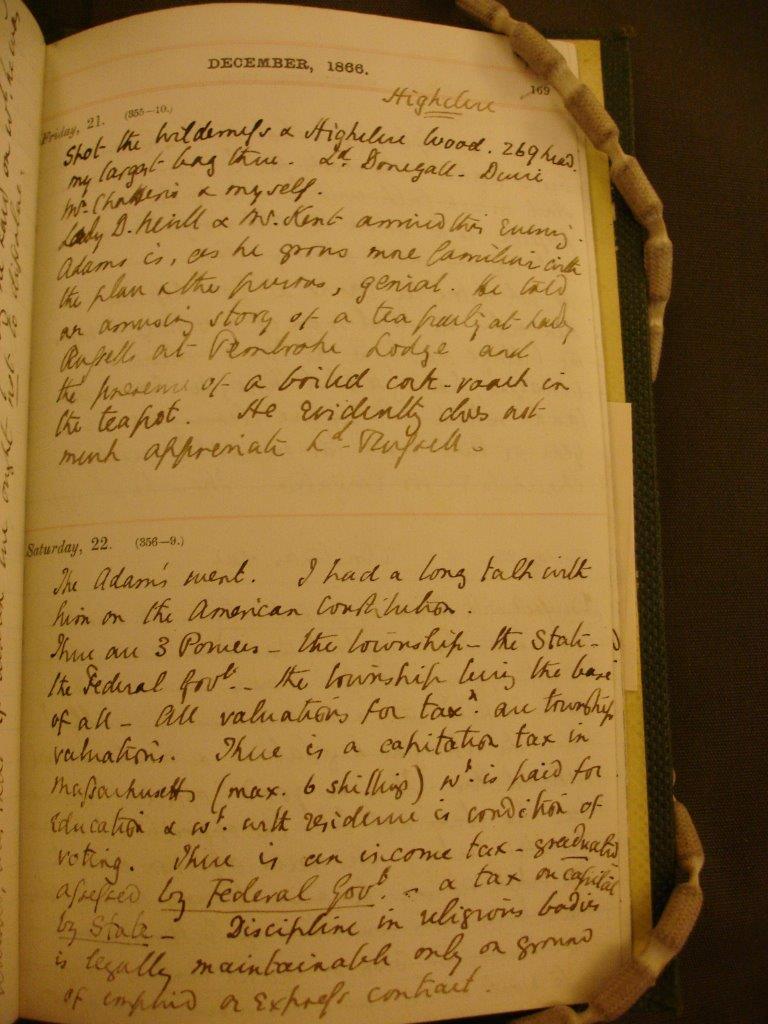 I came across much of the above when researching our Archives to write my book “At Home at Highclere”. I had no idea what I would find when I started but there is nothing more thrilling as a historian than reading about how a country was created and I feel truly honoured to have looked into a window in time. Given our knowledge of the world at the moment there is no greater gift than a tree and I hope it will survive well into the future along with Highclere itself.
I came across much of the above when researching our Archives to write my book “At Home at Highclere”. I had no idea what I would find when I started but there is nothing more thrilling as a historian than reading about how a country was created and I feel truly honoured to have looked into a window in time. Given our knowledge of the world at the moment there is no greater gift than a tree and I hope it will survive well into the future along with Highclere itself.








 Instagram
Instagram
Lady Carnarvon, your blogs are always special to me but being a Canadian this blog means so very much. I have your book, At Home At Highclere, ( a true delight) and remember reading this part of history on Canada. Wonderful! Delightfully Yours, Cheryl
Thank you Cheryl
MY DEAR LADY CARNARVON,
GOOD MORNING,
RÍO CLARO, RAINNY DAY, 36°CELSIUS.
I WOULD LIKE TO RECORD FOR THE HISTORY OF THIS BLOG THAT THE COUNTRY WHERE I WAS BORN “BRASIL”, IS THE ONLY ONE IN THE WORLD THAT ITS NAME DERIVES FROM THE NAME OF A “PAU -BRASIL TREE”,WICH IS A BLOOD-COLORED WOOD,THE COLOR OF EMBERS THAT GROWS ON THE BRAZILIAN COAST TO THE PRESENT DAYS,WHICH WAS SMUGGLED INTO EUROPE, SINCE THE DISCOVERY OF BRAZIL BY THE PORTUGUESE NAVIGATOR OF THE SEAS PEDRO ÁLVARES CABRAL IN THE YEAR 1500 TO DYE FABRICS ,THE COASTAL TROPICAL FOREST STILL EXIST TODAY TO A LESSER EXTENT DUE TO CONSTRUCTION OF CITIES COASTAL AREAS SUCH AS RIO DE JANEIRO, SANTOS, GUARÚJA AMONG OTHERS.
BEST WISHES.
VILA ALEMÃ
RIO CLARO – SP
BRAZIL
.
Good morning Lady Carnarvon,
I enjoyed reading this piece and learning about the history of the trees and gardens. I look forward to reading your book. Wishing you and Lord Carnarvon a wonderful week.
Here in Canada, it is early, but it was so encouraging to wake up today to your blog about Canada, and it’s connections to Highclere. We too are in the middle of the second wave , but dream of travel someday to Highclere. We will look for the maple tree, and maybe picnic under its branches! Best wishes to you and your family, and prayers for continued good health.
As a Proud Canadian, from New Brunswick (with many of the beautiful maples you describe) I was so interested in hearing about Lord Carnarvon’s involvement in the birth of our great country. I enjoyed your first book and am presently enjoying my newest Christmas one. I so look forward to your weekly blog posts.
Thank you – i thought bi would cook a series of recipes on the Instagram account too
I love you’re web page. It’s so informative, Take care stay warm and healthy.
That was a lovely read, its nice to get to know the history of Highclere before a visit.
Yours Patrick Mahoney
I highly anticipate these Monday morning blogs to begin my week.Having been born in New York state,the maple is dear to my heart as well. Thank you for another wonderful tidbit of history.
Fascinating history, superbly written!
A wonderfully entertaining history lesson on a Monday morning. I learned a lot! Thank you very much for sharing. (World class politicians, but the Adams weren’t known for their good looks, were they?)
!!! I like the fact that Charles Adams created the first Presidential Library ..whatever his looks
Good day Lady Carnarvon,
Thank you for another interesting and beautiful history about your amazing estate.
The 4th Earl was truly a visionary and man before his time as we here in the USA wrestle with limiting terms of those serving in the house and senate. We are indeed grateful that Canada is our neighbor to the north and England is one of our greatest allies.
Sincerely yours,
Theresa F
Dear Lady Carnarvon,
how wonderful to know that such significant history was made within your own four walls. It is a reminder of the important role houses such as Highclere have had throughout history, and the amazing people who, behind the scenes made things happen. The Maple tree is beautiful.
Kind regards,
Jane
DEAR LADY CARNARVON:
BEING CANADIAN I REALLY ENJOYED THIS BLOG ON SOME OF CANADA’S HISTORY. THE 4TH EARL SEEMED LIKE A SMART, REASONABLE AND COMPASSIONATE MAN. I AGREE WITH LORD CARNARVON IN REGARDS TO SOMEONE IN THE SENATE SHOULD ONLY SERVE ONE TERM. PEOPLE GETTING COMFORTABLE IN THE SENATE AND SPREADING THEIR POISON IS NOT BENEFICIAL TO THE PEOPLE.
DISCUSSION AND FRIENDSHIP, WE NEED MORE OF THAT IN POLITICS TODAY. HONESTY AND TRUTH IS MUCH NEEDED TODAY, ESPECIALLY IN CANADA RIGHT NOW.
THE CANADIAN MAPLE TREE IS A MOST BEAUTIFUL TREE. IT IS ONE OF MY FAVOURITE TREES. THE FALL COLOURS ARE BREATH TAKING. ENJOY YOUR MAPLE TREE, IT IS TRULY ONE OF GOD’S GREATEST CREATIONS.
CHRISTINA XOXOXO.
I agree Christina the maple tree is beautiful
Wonderful history! I’m sharing your blog today with my Canadian friends.
Thank you from Bellingham, WA.
Ina Sue Fox
Thank you
Lady Carnarvon
I always look forward to reading your blog every Monday morning over a cup of coffee. Thank you, for the insight into this bit of my country’s’ history.
Respectfully
Edward Kellner
Nova Scotia
Canada
A visit to the Adams Homestead National Parks museum in Ouincy, Massachusetts includes a look at Charles Adams’ study, a beautiful space that speaks to his intelligence and taste.
Thank you for the quick brief into the beginnings of our northern neighbor. I love the glorious maples.
Sincerely,
Carol Powers
Is it a sugar maple, or another type? Sugar Maples have a lot (like 1%) of sugar in their sap; you could start a new adventure making maple syrup!
It must be such fun reading the entries in this Highclere diary, especially when you come across this remembrance of tea at Pembroke Lodge, where a “boiled cock roach” in the teapot was worthy of reporting! I so love your blog. It has given me something to look forward to in this isolating time.
Sometimes a particular person is exactly the right fit for their place and time and everyone benefits. I think that is the case with you, Lady Carnarvon, and Highclere. We all benefit from your interest and passion for history and place. Thank you for these insights into the past.
I think I am lucky to live here too and lucky to have found Geordie
“I think that I shall never see…”
Lovely words and a much needed escape from the news of the day. Thank you, Lady Carnarvon!
Roberta Fox
Chicago
I know the news…
Thank you for this lovely piece of history. I look forward to every Monday morning and your always delightful blog. You bring a breath of fresh air to a world in turmoil. As we say in Texas, muchas gracias.
Thank you!
Lady Carnavron,
This essay was a welcome distraction from what is happening in the United States. I always find the long view of history comforting. Thank you.
Long views lift up our eyes
I so agree with this comment regarding history giving us the ‘long view’. My mother was a locally famous historian and I learned this great philosophy from her.
I am new to your blog, Lady Carnarvon, and am delighted that the first entry I read is about my home country and its connections to Highclere. No disrespect to the US intended, but I am grateful to your ancestor for aiding in the quick formation of Canada! (We love our maples, too.)
Cheers!
I am delighted to join the other Canadians who have left a comment today! Our Maple Trees are a source of pride and beauty in our country, and I hope your new tree will be a gorgeous shade of scarlet in the Autumn. I too, own a copy — and a signed copy, at that! — of your book “At Home at Highclere” which was a gift from my son who visited your beautiful estate in May of 2018.
Thank you for your historical insights, and for your weekly postings which are most welcome on Monday mornings.
Jeanne Kaye Speight
Fredericton, New Brunswick
Thank you – I have a letter proposing Fredericks town as a name for Canada!
Dear Lady Carnarvon:
As a proud Canadian, I had the opportunity to see this maple tree in person, while visiting Highclere Castle almost a year ago. I must say, the maple tree has grown very well over the past year. I look forward to its continued progress. It is nice to know that there is a connection between Canada and Highclere.
It is growing well – and we look after it
Lady Carnarvon,
You have so well connected the strength of early leaders like Charles Adams, son and grandson of US presidents, with the 4th Lord Carnarvon, with their ‘sensibilities of their times,’ ‘common sense’, and the ‘elastic’ thoughts on building a new Canadian constitution with the strength of the trees that surround the castle and its countryside. Trees represent strength and nobility through many decades, as did the intelligence and experience of these leaders in strengthening early Canada.
We here in America are struggling to reinforce our strength and national stability in this time of chaos. We need to plant some new trees in Washington DC to remind us of our national common sense.
Thank you for reminding us of the strength of Great Britain, Canada and the Unites States.
Martha G.
Dear Lady Carnarvon,
Thank you for this ‘inside view’ of Canada’s beginnings. It is so fortunate that Lord Carnarvon had the insight and wisdom to help with the beginning of the wonderful country of Canada.
I shall enjoy viewing the new maple tree next time I am at Highclere.
Best regards,
Cheryl Lewis
Thank you for your weekly blog which always contains something interesting and fascinating. As a sometime gardener I enjoyed reading about the Victorian gardens and their demise because of the intensive labor needed for their maintenance. And azaleas; they need that acid soil, not the naturally alkaline soil of Highclere. But taking advantage of what was done in the 1800’s to the soil by planting the Canadian maple in that particular spot not only is smart but helps tell some Highclere history in a meaningful way! Love it!
We in Marysville, Victoria suffered a terrible bushfire in 2009 so as a community we have landed 100’s of European and North American trees which are to some extent fire retardant. On our property we now have thriving liriodendrons (tulip trees) beeches and maples. If only people were more like trees……could drop their grievances, take a good rest, put on new clothes and spread beauty!
That is a lovely thought and accept the cycle of life
How wonderful for us to have that window to look back in time to know what those thoughtful, educated, forward-thinking men talked about while walking those gardens, admiring the trees, and helping to create history.
Oh Canada, how we love our neighbor to the north!
What a wonderful and educational post. Thank you!
I have planted three maples here in my yard in NW Montana. They are thriving and give us such pleasure in the fall when they turn a lovely dark maroon/hot pink. Does the soil’s acidity effect the color of the fall display? There is a very large native shrub here also called Rocky Mountain Maple which turns bright yellow all over the area. Squirrels love them, too! ‘Tisn’t even Spring yet and here we are, thinking about autumn colors!
All for now – take care,
Margaret
I know they prefer not to have the chalk soil here.. better conditions leads to better colours!
The topic AND tree, dear to my heart!
Thank you Heather!
Hello Lady Carnarvon,
I have also been following your nice posts on Instagram with interest!!
I shall go see that maple tree from Canada on my next visit to your beautiful estate.
Better than the maple tree itself is the maple water turned into sirup that it gives!
I hope you are well, I envy you to have dogs (and a very large private estate) to walk and keep you company, I’m home all day since last march, but usually not for many hours a day in our old normal life, so I’m hesitant to adopt another dog.
We are curfewed from 8 pm to 5 am here for a month… I love to read you always, thanks for keeping us company virtually! (c :
Bonne semaine!
Chantal
Montréal, Canada
Thank you – I thought today was all Canada – dogs and tree on Instagram!
Dear Lady Carnarvon! What a fascinating story about two topics close to my heart: trees and Canada. Before coming across the Big Pond I always assumed that all yearly calendars we had been gifted over the years were color enhanced. And then I saw the overwhelming beauty of dozens different species of maple trees while crossing from Michigan to Canada on a sunny day in late September. The beauty was unspeakable; the scale of hues from yellow, ochre, through pinks and Titian reds, to the deep purples and more. My entrance into the lovely Canada couldn’t have been more perfect! Thank you for your erudite storytelling!
Yours, Elizabeth
I have yet to see the sight! Although autumn is lovely too…
Dear Lady Carnarvon,
I’m sure you’ve heard this MANY times….You would make a terrific History Teacher. I love listening to your stories and how all of these prominent figures interacted. You bring History to life and make it fun to learn.
Have you thought about writing another book to follow “Catherine” to include your Husband’s parents? Of course, your stewardship is far from over so you couldn’t bring it up to present. Just a thought.
I follow you on Instagram and love watching your followers grow by leaps and bounds.
Happy 2021,
Peggy Helbling
A Faithful Follower from Windermere, Florida
I am busy writing …..
Lady Carnovon,
As always, an informative, delightful read. Thank you for your posts. Happy and healthy New Year to you, your family and all associated with Highclere.
Hello Lady Carnarvon,
Very interesting history. My husband was born and raise partially in Canada.
My Mum was born in Cheltenham. I have dual citizenship with Britain, and the U.S. Our daughter lives near Witney.
I would love to see archival photos of the gardens you mentioned, if any exist.
I love this blog.Thank you
I am a born in England raised in Ontario Canada and love our Maple Trees.
In the fall of the year when they all turn to red and gold they are a wonderful sight.
Thank you for writing this blog about Canada.
Enjoy your Maple tree.
Sincerely
Kathleen from Barrie Ontario Canada.
Thank you
Dear Lady Carnarvon:
Thank you for your Monday blog and sharing the story of the Maple tree and the brief history of the formation of Canada. Very nice photographs, especially the ones in color of the Maple leaves and the library at Highclere. (FYI: Detroit is the only place where you drive South to go North to Canada. You have to live here to appreciate that theory).
I agree with Lord Carnarvon’s position regarding service in the Senate. Here in the United States on the local level some term limits do exist. At the moment, there is a growing movement to bring that concept forward to national positions.
Well, until next Monday, have a productive week.
Perpetua Crawford
Thank you – it is busy here in the winter with the outside work so it is reassuringly productive in that is is cyclical
Dear Lady Carnarvon,
I enjoy everything you share with us and look forward to reading about Highclere past and present.
As I read today’s entry it occurred to me that anyone in the future who is going to do archival research will need to be able to read cursive.
I’ve thought for a long time that it wasn’t a good idea to stop teaching it in most schools. I suppose it will eventually be offered as a subject.
Thank you for sharing with us.
Donna Carl
Whitby Ontario
Canada
I find that quite scary – writing defines character! It is a good use of our hands
Thank you for leading me to look for the definition of “ericaceous.” I am a city dweller but hope to smile a knowing smile and include it in a conversation some day. Among your talents is teaching.
Thank you !!
Dear Lady Carnarvon,
As always, thank you for all your wonderful posts and especially this time for your fascinating tribute to Canada, and it’s first Prime minister Sir John A. McDonald. It was so interesting to learn about his connection to Lord Carnarvon, and with that said, how Lord Carnarvon’s significant contributions were so profound in Canada’s history! So informative! As a Canadian of Empire Loyalist heritage, I was very moved by this story.
Thanks again!
Wishing you and your family all the blessings of the new year!
Regards, Michael
Thank you – I found how Lord Carnarvon dealt with and brought in those who did not agree fascinating
Dear Lady Carnarvon,
Thank you for sharing your discoveries of the creation of Canada’s constitution. It must have been a thrill, once again, to find out another event that Highclere played an important role in history. Your husband has come from quite a legacy in his ancestors. You and he are continuing to wonderfully preserve it for the next generations.
I love maple trees, though we don’t have them in Hawaii but I enjoy seeing them in fall in Oregon.
Aloha,
Ada
I was so enthralled I could not believe it, I just remember being lost in it..
I enjoy reading your posts each time I visit. You often take the long view which is helpful in this difficult time. The tree is a wonderful gift and will stand as sentinel for many decades to come. That is fascinating how Highclere has a deep connection to the formation of Canada.
Thank you – we look after the tree ! It is precious
Lady Carnarvon, thank you for your interesting essays. They are very educational. I read and admire with great pleasure. Thank you !!
In certain locales in Texas, we have beautiful Maple trees. In West Texas, where I am, the Maples in the Guadalupe Mountains National Park are especially stunning in McKittrick Canyon, which runs from the Sonoran Desert up to the highest point in Texas, Guadalupe Peak at 8,751 feet
Best..
Wallace Craig
Midland Texas
As a Canadian living near Montreal, I so appreciated this article. Not only for your praise of the beauty of the Canadian Maple but also commemorating Sir John A., one of our founding fathers.
Sir John A. has been highly criticized here in Quebec and his statue has been desiccated recently. I find it so sad when societies judge their forefathers on beliefs, current in their times, yet very different in our modern society.
Thank you for this very interesting part of your history at Highclere and its link to Canada.
Lady Carnarvon, I thoroughly enjoyed this post as I grew up in Canada! It inspired a post on my own blog as I took down our Christmas tree ornaments, one of them being a spout for tapping into the maple tree for collecting sap to make maple syrup! I love the connection between Canada and Highclere; one day, I will visit and seek out that beautiful maple tree outside the Library! Thank you for your fascinating details about the castle and it’s grounds so we can travel in our minds right now!
Thank you
Lady Carnarvon Thank you so much for your wonderful history of our Canadian Country I really enjoyed your story about the Maple Tree. It truly is a gift God has given to Canada I have not visited your country but I love everything British My Grandfather was from London and I must have gotten some of his British love for England My bucket list has a visit to Highclere at the top Have a wonderful week Happy New Year
Happy New Year!
Love reading the history of Highclere since I was a huge fan of Downton Abby. Please keep posting more so we can learn more about this ancient and beautiful estate.
Dear Lady Carnarvon,
I am very late in responding this week; however, I am always fascinated by the history surrounding Highclere and the Carnarvon family. As a historian, you must be in heaven researching the many facets of the castle and those who lived and worked there. Thank you for sharing your vast knowledge with us.
Best wishes,
Pam Oates
Wonderful column again – spectacular photos.
Highclere is high on our bucket list once Covid is in the rear view mirror.
Fun fact:
Charles Adams parents John Quincy and Louisa were married in London at All Hallows by the Tower, which we’ve visited several times – a hidden gem very handy to the Tower itself.
Hope we’ll be visiting within another year! Meantime, all the best!
Randy Lamb
Maryland, NY
I had the good fortune to visit Highclere Castle in July 2017. It felt surreal being there after watching Downton Abbey episodes for 3 & often 4 times! I believe the 4th round of watching is attributed to the se Covid times. I have read your book “Lady Catherine and the Real Downton Abbey” & enjoyed it immensely!
May the general interest of Highclere Castle continue.
Cheers
Sherrill Stone
Campbell River, BC
Canada
Thank you – have you read ALmina?
How wonderful to read more of Lord Carnarvon’s role in the emergence of Canada. I wish he had been able to convince others of the idea of serving in the Senate for a term, rather than for life, as it is now. There is a Carnarvon Street in Vancouver named in his honour.
Won’t it be lovely when we can visit one another again, and have guests in our homes? I long for that day to come.
Dear Lady Carnarvon
I thoroughly enjoyed your Monday column as usual, always something new and fresh to disclose to those who follow the happenings at Highclere.
Having recently purchased both At Home at Highclere and your book about Lady Almina I was intrigued to see the latter had apparently been signed by you. My husband is a printer and we were unsure whether this is your signature on each copy or whether it is reproduced to appear that way (which would be entirely understandable !). I should love to know, either way, if you are kind enough to reply sometime. In any event, I look forward to reading about your beautiful home, which we have been fortunate enough to visit, and the Edwardian period is my favourite so I can’t wait to see what is disclosed in text and photographs between the covers of this book !
Sandra Willcox,
Kent, UK
I do sign books – they are roughly the same but I am often listening to the radio whilst I sign so they are all not the same!!!
Wonderful chance to read the interesting info about Canada. Have two sisters and a son living in Canda and I do so enjoy my visits ,beautiful country with beautiful people. Looking forward to a visit in the not too distant future.
Hello Lady Carnarvon,
I enjoy reading all your letters and the replies you send to your readers. Just one question, please. What breed of dog are the dark rusty-brown dogs in the picture with the maple tree?
I used to own 2 Rhodesian Ridgebacks many years ago. Are they the same? I loved them!
Thank you very much and keep well.
Mona Aaron
Montreal, Quebec
Canada
The two dark rusty brown dogs are my faithful 8 year old Labradors